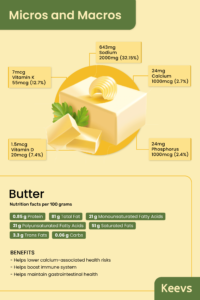Vitamins in Butter: Health Benefits and Butter Nutrition Facts

Butter isn’t just a slab of fat, it is nutritious and can offer amazing benefits if consumed in the right proportions.
All you have to do apart from enjoying your meal that consists of butter, is to watch your intake and you’re good to go!
Butter, oh such a nostalgic ingredient!
My childhood would be incomplete without butter, especially when it is eaten with warm toast.
Was butter also a part of your diet?
Read on to find out more about butter and maybe you can then add it to your diet if it isn’t on it already!

How would you describe butter?
Butter, a dairy product found in almost every household and that has become a go-to staple snack, has more to it than what is perceived of it, i.e. as a slab of fat.
The word butter was derived from the Latin word butyrum. The Latinized form of this word is found in the name butyric acid, a compound found in rancid butter and other dairy products.
Butter is an emulsified fat that is formed by churning milk or cream.
The churned milk or cream separates to form a layer of fat molecules which is then collected and processed.
In India, we make butter from dahi, a fermented milk product; that adds a unique flavor while also making it rich in nutrients like vitamins, fats, proteins, and carbs.
It can be used as-is on toast, corn, or even breakfast items like dosa; it can also be added to various dishes as an ingredient.
Nowadays, you can find butter in various flavours
- Salted butter
- Unsalted butter
- Garlic butter
- Garlic and herb butter
- Lemon, ginger, and chilli butter
And the list goes on!
| People who consume butter daily have shown an improvement in their gut health due to the presence of butyrate, a type of short-chain fatty acid. |
When one thinks of butter, they assume that it is unhealthy and not ideal to be put in a diet; but, the vitamins in butter can be highly nutritious when consumed in the right proportions.
Recent research has shown that butter does not significantly affect one’s chances of developing cardiovascular diseases, diabetes, or affect their mortality. (1)
Did you slap a lot of butter on your toast as a child or maybe even as an adult?!
| Yes! Wasn’t that the norm?! | Nope. I wasn’t a fan. |
If you answered yes, then we have some great news for you!
Butter has so many benefits, some of which I’m sure you weren’t even aware of, and consuming ample amounts of it can
- Keep your skin looking young and youthful due to the presence of vitamin E
- May play a role in keeping cancer at bay due to the presence of vitamin A
- Support bone health due to the presence of vitamin D
- Contribute to your eye health, again due to it being rich in vitamin A
These benefits are due to the vitamins in butter along with various other nutrients.
Vitamins in butter, how beneficial are they?
Vitamins to your body are like nitrogen to plants. They may not be the most obvious requirement, but they definitely are essential.
Therefore, having foods rich in vitamins impacts your health positively.
The following are vitamin facts for 100g of salted butter according to the USDA. (2)
| Vitamins and Minerals | Content in 100g | RDA (% of total RDA) |
| Vitamin A | 684 mcg | 900 mcg (76%) |
| Vitamin K | 7 mcg | 90 mcg (7.7%) |
| Vitamin D | 1.5 mcg | 20 mcg (7.5%) |
| Vitamin B12 | 0.17 mcg | 2.2 mcg (7.7%) |
| Sodium | 643 mg | 2000 mg (32.15%) |
| Phosphorus | 24 mg | 700 mg (3.4%) |
| Calcium | 24 mg | 1000 mg (2.4%) |
| Potassium | 24 mg | 3400 mg (0.7%) |
| Iron | 0.02 mg | 18 mg (0.11%) |
| Magnesium | 2 mg | 420 mg (0.4%) |
| Vitamin E | 2.32 mg | 15 mg (15.46%) |
What other nutrients is butter rich in?
Apart from the vitamins in butter, there are also other nutrients present. All of them bring their own benefits.
The following are nutrition facts for 100g of salted butter according to the USDA (2)
| Nutrient | Content in 100g | RDA (% of total RDA) |
| Saturated fats | 51.368 g | 30 g (171%) |
| Trans fats | 3.3 g | 2 g (165%) |
| Fat | 81.11 g | 77 g (105%) |
| Polyunsaturated fats | 21 g | 22 g (95%) |
| Monounsaturated fats | 21 g | 44 g (48%) |
| Protein | 0.85 g | 52 g (1.6%) |
| Carbs | 0.06 g | 130 g (0.04%) |
Although 100g of butter has 717 kcal calories and 0.06g of sugar, its other nutrients prove to be highly beneficial.
Therefore to say butter is indeed nutritious, wouldn’t be wrong.
Daily consumption of butter can be healthy, and if you’re on a keto diet, it might even fasten your weight loss journey!
More beneficial ingredients or compounds in Butter
- Butyrate
Butter is rich in butyrate, a short-chain fatty acid that supports digestive health. (3)
- Lactone
Lactones, a compound found in butter, can help lower blood pressure and is also effective in tumour treatment. (4)
- CLA (conjugated linoleic acid)
CLA is a naturally occurring fatty acid found in butter, can help lose fat and may help in bone mineralization. (5)
Butter Nutritional Information
Nutrition Facts
Serving Size100g
- Amount Per ServingCalories717
- % Daily Value *
- Total Fat
81.11g
125%
- Trans Fat 42g
- Sodium 643mg 27%
- Potassium 24mg 1%
- Total Carbohydrate
0.06g
1%
- Sugars 0.06g
- Protein 0.85g 2%
- Vitamin A 684%
- Calcium 24%
- Iron 0.02%
- Vitamin D 1.5%
- Vitamin E 2.32%
- Vitamin K 7%
- Vitamin B12 0.17%
- Phosphorus 24%
- Magnesium 2%
* The % Daily Value tells you how much a nutrient in a serving of food contributes to a daily diet. 2,000 calories a day is used for general nutrition advice.
Health Benefits of Butter
Butter is nutritious, yes. But how does it benefit our body? Are the nutrients and vitamins in butter beneficial to our body and its functions?
Let’s find out!
Helps lower calcium-associated health risks(6)
Vitamin K2 that is abundantly found in butter, inhibits arterial calcification and arterial stiffening, which means it inhibits the collection of calcium in the arteries and prevents it from stiffening. Adequate consumption of K2 lowers the risk of vascular damage because it activates the matrix GLA protein (MGP), which inhibits calcium deposits on the walls.
Vitamin K2 can also optimize calcium use in the body hence preventing any potential adverse health impacts associated with increased calcium intake.
It also helps prevent tooth decay and maintain bone structure and strength.
Helps boost the immune system (7) (8)
Lauric acid, a fatty acid found in butter, is used to treat various viruses, bacterial infections, and fungal infections. Butter, therefore, acts as a natural antibiotic and can also help modulate your immunity.
Lauric acid is also less likely to promote insulin resistance, inflammation, and fat storage. It has an increased fatty acid oxidation rate and is most likely burned for energy and less likely to be stored in the adipose tissue.
Helps maintain gastrointestinal health (3)
Butter contains butyrate, a short-chain fatty acid that can improve the intestinal barrier function.
Butyrate can help improve metabolic, colonic, and renal function in the human body.
It can also help decrease inflammation and improve digestive health.
| In a nutshell, the vitamins in butter and the compounds present to contribute to your overall health. It can keep your skin, eyes, bones and teeth healthy while also ensuring to maintain your immunity, gastrointestinal health and keep calcium associated health risks at bay. |
How to use butter?
Butter is a very simple ingredient and doesn’t require much to provide a delicious meal or snack.
One might even call it low maintenance!
- You can spread some on a bagel or a slice of bread
- You can add it to your pasta for a more creamy texture
- And if you want to go desi, you can use it to prepare the infamous butter chicken.
Butter can be salted, unsalted and have a flavouring.
One of the most popular ones is garlic butter.
Garlic butter on a slice of toasted bread with some oregano can be a quick fix for some store-bought garlic bread.
How much butter can you consume in a day?
Since butter is saturated fat, it is always best to watch your intake. The recommended consumption would be 10% of your total calorie, or approximately 3 tablespoons a day.
Butter is ideally paired with toast and is had for breakfast. It is also used for seasoning various dishes and can be the main ingredient for others.
What if I consume in excess?
Although healthy, overconsumption of any food item is harmful. In this case, consuming more than 10% of your calorie intake in a day can cause various health issues.
Some of them being:
- An increase in bad cholesterol
- Can contribute to the development of visceral fat
- Can lead to obesity
- Can increase triglyceride levels in the blood
How to store and choose the right type of butter?
Storing butter is relatively easy. Keeping it in an airtight container and leaving it in the freezer should be enough to keep it fresh for a long time.
Remember to defrost it to make it easy to use.
There are two types of butter to choose from:
- Grass-fed butter, and
- Regular butter
The main difference in its production is what the cows were fed.
Grass-fed butter is known to contain more omega -3 fatty acids and less saturated fats.
Therefore, picking grass-fed butter over regular butter is beneficial and will work in your favour.
Wrapping Up
To conclude, we would like to reiterate that butter is healthy when consumed in the proper proportions.
It can offer various health benefits, from the skin to the intestine.
However, every food item comes with its pros and cons; therefore, watching your intake will help you keep the cons at bay and give you an overall pleasant experience!
Does this change your opinion on butter? Let us know in the comments below!
References
- Pimpin, Laura et al. “Is Butter Back? A Systematic Review and Meta-Analysis of Butter Consumption and Risk of Cardiovascular Disease, Diabetes, and Total Mortality.” PloS one vol. 11,6 e0158118. (2016)
- USDA. “Butter.” Food Data Central, (2019)
- Canani, Roberto Berni et al. “Potential beneficial effects of butyrate in intestinal and extraintestinal diseases.” World journal of gastroenterology vol. 17,12 (2011): 1519-28.
- Chadwick, Martin et al. “Sesquiterpenoids lactones: benefits to plants and people.” International journal of molecular sciences vol. 14,6 (2013): 12780-805.
- Lehnen, Tatiana Ederich et al. “A review on effects of conjugated linoleic fatty acid (CLA) upon body composition and energetic metabolism.” Journal of the International Society of Sports Nutrition vol. 12 36. (2015)
- Maresz, Katarzyna. “Proper Calcium Use: Vitamin K2 as a Promoter of Bone and Cardiovascular Health.” Integrative medicine (Encinitas, Calif.) vol. 14,1 (2015): 34-9.
- Harrison, Lisa M et al. “Dietary fatty acids and immune response to food-borne bacterial infections.” Nutrients vol. 5,5 (2013:1801-22.
- DiNicolantonio, James J, and James H O’Keefe. “Good Fats versus Bad Fats: A Comparison of Fatty Acids in the Promotion of Insulin Resistance, Inflammation, and Obesity.” Missouri medicine vol. 114,4 (2017): 303-307.
![Blue Foods List [with pictures]](https://keevs.com/wp-content/uploads/2023/03/Blue-Foods-List-with-pictures-300x158.png)






